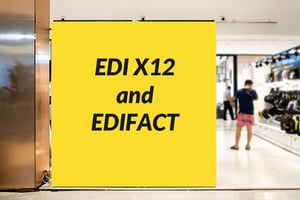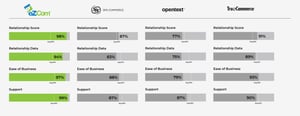What’s up with Amazon?
The largest, most important online marketplace moves quickly. So quickly, in fact, that it seems like their own Prime Video service could launch a show called Keeping Up with the Amazons and never be short of material. The most recent episode: Amazon Vendor Central Suppliers being shifted to Amazon Seller Central.
Or not. Or sort of. In other words, the plot thickens.
Let’s start with this. Thousands of suppliers recently discovered their regularly scheduled Amazon Purchase Orders — which typically arrive each Monday — failed to appear. And the reason they didn’t show up was simple: Amazon didn’t send them. The suppliers were then informed their Vendor Central status had been terminated and that, if they desired, they could move their business to the Seller Central channel.
At first, there seems to have been some confusion in Seattle, as Amazon blamed a technical glitch for the failure of the POs to turn up. But it turns out the reason behind the missing POs wasn’t a coding issue but part of a business strategy.
Before long, Amazon sent most vendors who were missing POs an email message, essentially letting them know that they would get those POs after all. Some vendors were told they also needed to enroll in the Amazon Brand Registry, used to protect the trademarks of brand owners and prevent counterfeiting. Vendors who don’t own the brands they sell may be required to shift to a Seller Central account in the next 60 days.
Amazon is change. Adapt to it.
The reality is that Amazon, by many metrics, is the most important company in the world. So for better or worse and whether you like the decision or you don’t, they get to set the rules. That’s not changing anytime soon. With nearly two billion people visiting Amazon each month and its status as the #1 online destination when people launch product searches, suppliers will continue to rely on Amazon and the company will continue to dictate terms.
That means your company needs to be able to adapt, and should also be working with an EDI and order management provider that is nimble. After all, if you have been an Amazon Vendor Central supplier, being forced to move to the Seller Central platform is, at the very least, unsettling.
What is the long-term plan for the Amazon channels?
Few companies are as agile as Amazon. Indeed, much of its success can be attributed to its ability to move with remarkable swiftness for such a large corporation. The shoestring internet startup that began by selling books and CDs is now a corporate behemoth that makes movies, runs a massive cloud storage operation, streams music and, of course, sells virtually everything.
That ability to turn on a dime and enter into new ventures is reflected in the way the company manages the suppliers who rely on it to sell products. Throughout its history, Amazon has introduced many different channels for selling merchandise across its platform. In recent days, some have speculated that a consolidation is in the works, and that shifting suppliers from Vendor Central to Seller Central is a harbinger of a larger move towards something new called One Vendor. Amazon, however, denies that such a program exists.
There is little question, however, that Amazon will enjoy greater profitability when more sellers are on the self-serve, third-party marketplace that is Seller Central. And it leaves them with more time and resources to focus on maintaining strong relationships with major consumer product companies like P&G, or technology powerhouses like Samsung.
Vendor Central suppliers and moving to Seller Central.
So where does this leave suppliers? Rather than spend time speculating, let’s start with what you know right now.
If you didn’t receive your Purchase Orders, you’re probably being shifted from Vendor Central to Seller Central. That’s not necessarily the worst thing, but Seller Central is a platform that has real ramifications for your business model.
The nature of your Amazon order management will be sharply different. Instead of selling to an Amazon retail buyer — the typical wholesale-style Vendor Central transaction — and then letting Amazon market and sell your products, Seller Central is self-directed. You’re now the one who lists, sells, and markets your products.
Stay positive.
Let’s start with the upsides of Seller Central.
You get more control, especially on pricing, and that can produce better per-item margins, especially if you dive into the robust analytics to generate new ideas for boosting sales. And your connection to customers is direct because you’re now the primary point of contact — not Amazon.
You also control logistics. While some Seller Central suppliers pay extra for the Fulfilled by Amazon service, many choose Fulfilled by Merchant and either handle it themselves or rely on a 3PL. While that can mean more work for you and your team, it also means you can manage your inventory more effectively.
One other positive that has come out of this recent Amazon episode: Seller Central vendors will no longer be prevented from selling their products in other places at lower prices than consumers will find on Amazon. It’s a dramatic shift for a company that’s built its business, in part, on being incredibly competitive on price.
But remain realistic.
We won’t sugarcoat this: there are some things you’re going to miss about Vendor Central.
First, while you have additional control, your products won’t have the “Sold by Amazon” label that generates trust and confidence among many shoppers. For many buyers, that’s a stamp of approval they actively seek out. But it may not be as critical as you think — if your products already have a steady following, your customer base probably won’t be too concerned or might not even notice the change.
You will, however, need to take a more active role in the marketing of your items since you won’t have the benefits of Amazon Marketing Services (AMS). That will be disappointing if you have spent a number of years learning how to maximize AMS. But, again, you will be gaining control on Amazon Seller Central.
Finally, with Seller Central, you’ll be paying typical Amazon fees on every order. That will be a change from the flat fee you paid as a Vendor Central supplier.
What’s the bottom line?
Even if you haven’t been told you’re being shifted to Seller Central, it’s prudent to prepare for that or the creation of another, different Amazon channel.
In a statement provided to Digiday, Amazon noted, “We regularly review our selling partner relationships and may make changes when we see an opportunity to provide customers with improved selection, value and convenience.”
The best way to handle change is expect it. And be ready when it happens. That means figuring out how to get the most out of your Amazon business and diversifying into other channels so you’re not completely reliant on it.
As unwelcome as a shift to another Amazon platform might be, eZCom clients can take comfort in the fact that our Lingo software is built to handle the order management demands of both Seller Central and Vendor Central. If you’re being shifted to Seller Central and now need to manage the customer relationship more directly, the Lingo platform gives you the tools you need to succeed. What’s more, our integration team can also create a solution that could reduce your staff workload by bringing order information into the system that powers your business. If you have not already done that, you may want to give it careful consideration — integration offers advantages like seamless efficiency and significant cost-savings.
Despite the fact that you probably have initial, very valid concerns, a shift to Seller Central can produce long-term dividends. The change may be difficult to manage in the early stages, but other suppliers have found that additional control leads to greater profits and an improved business model.
No matter what happens, it’s the rare vendor who can walk away from the world’s most important online marketplace. It makes far more sense to ensure you are ready to adapt to shifts in the way Amazon operates and a major component of that is working with an EDI and order management provider that is ready for anything. If you’re an eZCom client, you already have that part of the equation solved.






